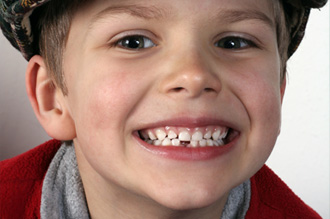Early Treatment
How to Choose an Orthodontist | For Children & Adults | Why Braces? | Early Treatment | Treatment

The American Association of Orthodontists (AAO) recommends that children be examined at age two by the family dentist. In addition, AAO recommends the first orthodontic exam be conducted at age seven. Few cases should be started this early, however it does give the orthodontist and the parents the opportunity to chose the most advantageous time for treatment depending on the situation.
If the jaw bones are of proper size and relate well to one another, in most instances, braces should not be started until all permanent teeth have erupted. This is generally about age eleven to twelve for females and a year or so later for males.
There are few occasions where it is beneficial or healthy to place braces before the permanent teeth have fully erupted. There are instances of moving permanent tooth roots into unerupted teeth causing impaction of those teeth or damage to the roots of the teeth on which the braces are placed. If, however, there is crowding of teeth due to small dental arches, or large teeth, or if the jaws do not relate properly to one another, then early treatment should be considered.
In times past, it was often chosen to extract certain baby teeth in order to help the permanent teeth erupt and align themselves. While this had certain advantages, the price had to be paid by later extracting four permanent teeth, usually first bicuspids, the teeth directly behind the canine or cuspid teeth (eye teeth). This has long term implications for the child as to appearance of the teeth and structure of the face.
A preferred method when crowding is present due to small jaws is to expand the upper and lower dental arches with removable appliances. When only the upper jaw is expanded and the lower is left narrow, the amount the upper can be expanded is limited. While jaw expansion is being done, it is also possible to optimize the growth of the lower jaw as well. Treatment with removable appliances generally occurs without any discomforts whatsoever and can improve facial features.
Although we do not have the capability to create growth beyond the child's potential, we can remove impediments to optimal growth, often with dramatic results. Left uncorrected, good growth can often be a detriment if a deep overbite exists since additional pressures may be placed on the patient's jaw joint (TMJ or temporomandibular joint).
When treatment is indicated for crowding, excessive overbite or protruding teeth, we prefer removable appliances that very gently move the teeth as compared to heavier forces that may be generated by headgear or some of the fixed appliances (attached to the teeth) that are often employed in early treatment.
Following completion of early treatment, the child is given a "rest" while awaiting maturation of the rest of the teeth. Generally a simple retainer in one or both jaws is all that is necessary to maintain the gains (and often to enhance them) while the child's growth continues.
Some cases require no treatment after completion of phase one treatment. The teeth have improved enough that further alignment is no longer necessary or can be optional. In most instances the family can choose to do the braces or Invisalign at any age since growth is not needed to finish tooth alignment. Growth is certainly beneficial during the phase one treatment. If braces are done in phase two, they are usually worn for one-half the time (12-15 months) that braces are traditionally worn. Invisalign treatment time may be even less.
To sum up, early treatment can have the advantage of making treatment easier and more effective by enhancing facial features, possibly avoid unnecessary extractions and cause treatment to be performed with less discomfort. Each case should be evaluated on its own merit and the options explained before a decision is made. We invite your questions and concerns.



